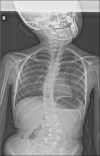Chronic atlantoaxial rotatory fixation with neurofibromatosis type I: A case report
- PMID: 35242406
- PMCID: PMC8888303
- DOI: 10.25259/SNI_1171_2021
Chronic atlantoaxial rotatory fixation with neurofibromatosis type I: A case report
Abstract
Background: Atlantoaxial rotatory fixation (AARF) can be caused by infection, rheumatoid arthritis, surgery of head and neck, and congenital diseases. Type 1 neurofibromatosis (NF-1) is often associated with various musculoskeletal diseases, but few reports have described AARF with NF-1. Here, we report the success of a closed reduction and halo fixation utilized to treat chronic AARF with NF-1 in a 7-year-old female.
Case description: A 7-year-old female with NF-1 presented with a 2-month history of torticollis and neck pain. C2 facet deformity had previously been identified on computed tomography (CT) before the onset of neck pain. Cervical radiography and CT showed AARF classified Fielding's Type I and Ishii's Grade II. Following 2 weeks of cervical traction, a closed reduction was followed by halo fixation that was utilized for 2 months. The patient fully recovered cervical range of motion following halo vest removal 4 months later. Further, the follow-up CT documented a normal atlantoaxial joint despite residual C2 facet deformity. In addition, no recurrence was evident 2 years later.
Conclusion: Halo fixation for chronic AARF with NF-1 proved effective. C2 facet deformity associated with NF-1 might have contributed to the onset of AARF.
Keywords: Chronic atlantoaxial rotatory fixation; Halo fixation; Neurofibromatosis type I.
Copyright: © 2022 Surgical Neurology International.
Conflict of interest statement
There are no conflicts of interest.
Figures






References
-
- Akbarnia BA, Gabriel KR, Beckman E, Chalk D. Prevalence of scoliosis in neurofibromatosis. Spine (Phila Pa 1976) 1992;17(Suppl 8):S244–8. - PubMed
-
- Burkus JK, Deponte RJ. Chronic atlantoaxial rotatory fixation correction by cervical traction, manipulation, and bracing. J Pediatr Orthop. 1986;6:631–5. - PubMed
-
- Craig JB, Govender S. Neurofibromatosis of the cervical spine. A report of eight cases. J Bone Joint Surg. 1992;74:575–8. - PubMed
-
- Fielding JW, Hawkins RJ. Atlanto-axial rotatory fixation. (Fixed rotatory subluxation of the atlanto-axial joint) J Bone Joint Surg Am. 1977;59:37–44. - PubMed
-
- Ishii K, Chiba K, Maruiwa H, Nakamura M, Matsumoto M, Toyama Y. Pathognomonic radiological signs for predicting prognosis in patients with chronic atlantoaxial rotatory fixation. J Neurosurg Spine. 2006;5:385–91. - PubMed
Publication types
LinkOut - more resources
Full Text Sources
Research Materials
Miscellaneous
